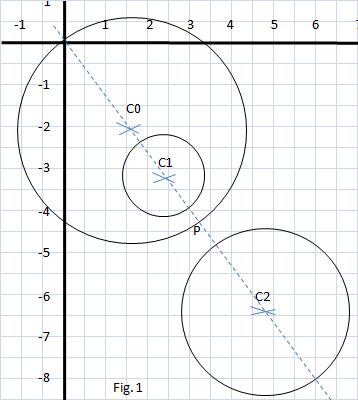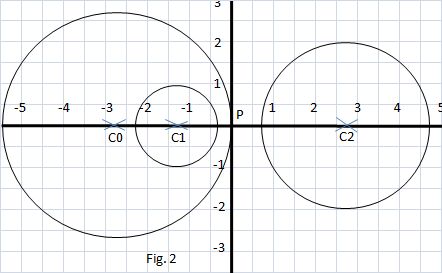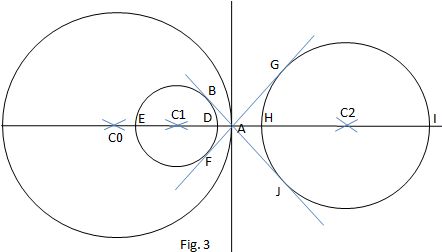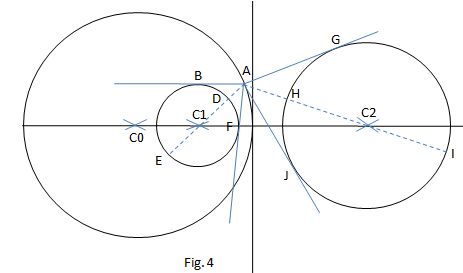The lengths of the tangents from any point on the circle #15x^2 + 15y^2 -48x +64 y =0# to the two circles #5x^2 + 5y^2 -24x +32y +75 =0# and #5x^2 + 5y^2 -48x +64y +300 =0# are in the ratio?
1 Answer
Explanation:
To give an idea of what is intended, take a look at the radical axis, the locus of points where the tangents of two circles meet at the ratio 1:1
First let's rewrite the 3 circles' equations
Showing the way with the first equation:
#15x^2+15y^2-48x+64y=0#
#x^2+y^2-16/5x+64/15y=0#
#-> -2x_0=-16/5# =>#x_0=8/5#
#-> -2y_0=64/15# =>#y_0=-32/15#
#-> x_0^2+y_0^2-r^2=0# =>#r^2=64/25+1024/225# =>#r=8/3#
#circ_0 -> (x-8/5)^2+(y+32/15)^2=(8/3)^2#
Following this way
#circ_1 -> (x-12/5)^2+(y+16/5)^2=1^2#
#circ_2 -> (x-24/5)^2+(y+32/5)^2=2^2#
Graphing these three circles we'll get something like the figure below

Please remark that the circles' centers (
The slope of the line in which they are is
Finding the point P (combining equation of circle-0 and equation of the line,
#(x-8/5)^2+(y+32/15)^2=(8/3)^2#
#(x-8/5)^2+(-4/3x+32/15)^2=64/9#
#x^2-16/5x+64/25+16/9x^2-256/45x+1024/225-64/9=0#
#25/cancel(9)x^2-80/cancel(9)x=0# =>#x_1=0# (not valid);#x_2=16/5#
#-> y=-(4/3)x=-(4/3)16/5# =>#y=-64/15#
#-> P(16/5,-64/15)#
Next step will be to translate point
With this translation the circles' centers
#C_0 (8/5,-32/15), C_1 (12/5, -16/5) and C_2 (24/5, -32/5)#
become
#C_0 (-8/5, 32/15), C_1 (-4/5, 16/15) and C_2 (8/5, -32/15)#
Now these points will rotate
Since the line common to the three circles' centers will become coincident to the new x-axis (
#x'=x*cos(-phi)-y*sin(-phi)#
#x'_0=(-8/5)*cos53.15^@-(32/15)*sin53.15^@=-2.667=-8/3#
In this way
#x'_1=-1.333=-4/3#
#x'_2=2.667=8/3#
So, after the translation and rotation
#C_0 (-8/3,0), C_1 (-4/3,0) and C_2 (8/3,0)#
(see figure 2, below)

Consider special case of Figure 3

In the special case we can see that
#AD=C_1A-r_1=4/3-1=1/3#
#AB^2=AD*(AD+2r_1)=(1/3)(1/3+2*1)=7/9# =>#AB=sqrt(7)/3#
#AH=C_2A-r_2=8/3-2=2/3#
#AG^2=AH*(AH+2r_2)=(2/3)(2/3+2*2)=28/3# =>#AG=2sqrt(7)/3#
So the ratio#(AB)/(AG)=1/2#
Now for the general proof
Consider Figure 4

As we saw above
#AB^2=AD*(AD+2r_1)#
Or
#AB^2=[(AD+r_1)-r_1]xx[(AD+r_1)+r_1]#
And
#AG^2=[(AH+r_2)-r_2]xx[(AH+r_2)+r_2]#
The equation of the circle-0 in polar coordinates is
#r=-2a*cos theta# =>#r=-16/3*cos theta#
Points
#C_1 (4/3, pi) and C_2 (8/3,0)#
The distance between two points in polar coordinates is
#d=sqrt (r_a^2+r_b^2-2*r_a*rb*cos(theta_a-theta_b))#
So the distance between
#AB^2=[4/3sqrt(8cos^2 theta +1)-1][4/3sqrt(8cos^2 theta+1)+1]#
#AB^2=[16/9(8cos^2 theta +1)-1]=(128cos^2 theta +7)/9#
And the distance between
#AG^2=[8/3sqrt(8cos^2 theta+1)-2][8/3sqrt(8cos^2 theta +1)+2]#
#AG^2=[64/9(8cos^2 theta +1)-4]=(512cos^2 theta +28)/9#
#AG^2= 4*(128cos^2 theta +7)/9#
So
And the ratio is

